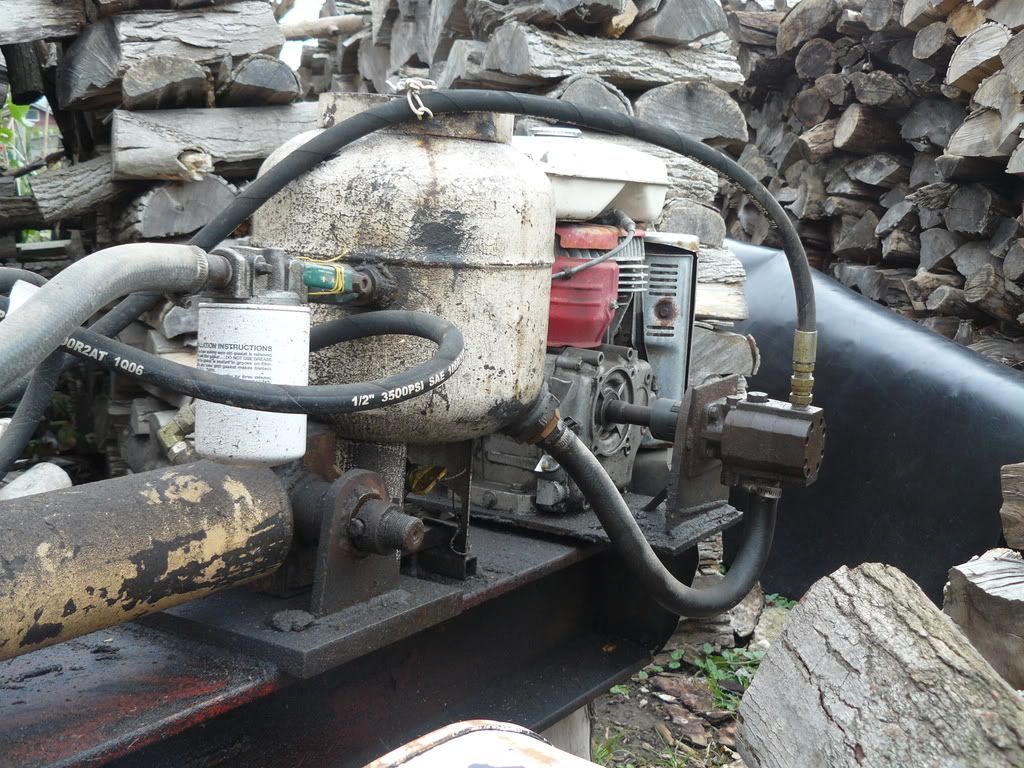Couple previous posters got it:
As the cylinder strokes out (or in), most of the air is pushed out but not all if the ports are sideways. Let’s say it has cycled, but the closed end has that cubic inch of air above the ports when totally retracted. The next time it extends and hits a load and builds pressure, that bit of air, even only a cubic inch, then compresses basically full of oil (to maybe .01 cubic inch compressed 100 to 1 or so) to say 2500 psi. Then when the valve is shifted to retract, the oil pressure immediately drops and starts back through the filter from the pump, Before anything even moves, this little bubble at 2500 psi expands back to one inch at 20 or 50 or whatever psi. Acts like a spud gun in a way-sends one cubic inch into return and filter. Doesn't sound like much, but 1 cubic inch in a few milliseconds is mega gpm. Since flow creates pressure drop, the line pressure sees a spike faster than a gauge can see, but blows the can.
That was my original theory, thinking he put the valve into retract and it blew. OP said pulled to neutral but not yet to retract. Thus, this trapped bubble is in the cylinder (valve is blocked center, at least I assume so?) and the pressure doesn’t blip to the filter yet. Hence my later theory that the compressed oil/air that is relieved of pressure and can expand to send the surge would have to be in the line before the valve. The oil moves through a second after pump starts and air in the hose would have been gone long before. The only way I can envision a continuous supply of compressible air/oil is if there is a suction hose leak, a pump shaft seal leak, low oil level, or extremely aerated oil in the tank. This is a likely culprit, if there was a lot of trapped air stirring things up and still entrained in the oil in the tank.
I have seen a 4 foot x 5 foot tank lid, with 200 lbs of air filters and fans for other stuff, blow off over 75 feet into the weeds at a startup. Hydraulic fluid trapped in one corner couldn’t get away fast enough, it pressured the lid, bolts tore, the resulting snapping steel bolts ignited the seriously aerated fluid and boom. No one hurt, increased WalMart sales for new underwear.
Usually air at startup is harmless. If this was one of those normal weird startup issues, especially with aerated oil as the culprit, no more worries. You needed the bigger return lines anyway, good change. I would still check the tank oil for aeration, and all suction connections just to be sure it was a one time thing.
Air in a cylinder with resistance load, always pushing or pulling, is safe and will purge out. A cylinder that goes past center, from pushing to pulling, can be very dangerous at first startup if not properly purged. The push side fills with oil, slowly, as the valve is metering the oil INTO the cylinder. The other side is still full of air. When the load goes past center, if the cylinder far side is full of oil, it is controlled by the valve restricting flow OUT of the far side. If that side is full of air, when it starts to overrun, the spool can be totally closed and the cylinder won’t stop. It just compresses the air in the cylinder and hoses and keeps going with the load.
Eric-farm machinery: fold up wings on a disc or chisel. The wings are folded up, past center, and tend to fall to the inside when stowed for travel. Usually a toggle linkage and cylinder pushes them out (a resistive load) until it goes past center at straight up, and turns into an overrunning load. Control on the way down is from metering OUT of the cylinder not in. If full of air, no control, throws that puppy down so fast the earth shakes. Or so I’ve heard…. Even cycling back and forth a few inches before it goes past center won’t properly purge air in that situation. They may have to be loosened hose and bled out. Or better, change cylinder with wings on the ground…
Eric, it’s coming slow. I’m going to PM you a file on Pumps for review.
Here is a good site for farm machinery discussion. Also many other BB back at the home page, this one is machinery.
http://talk.newagtalk.com/forums/forum-view.asp?fid=2
kcj

























































